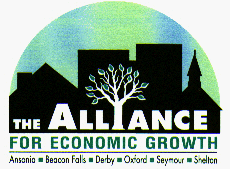
Lower Naugatuck Valley 2000
|
Bookmarks to sections of application |
|
| Application Home Page | Project One |
| Community Background | Project Two |
| Civic Index | |
Project Three - Alliance for Economic Growth
3A. Briefly describe the third main project (Project Three) of the three projects that has significantly impacted the community since 1997.
In 1994, as an outcome of a community leadership retreat, three Valley towns came together for the first time to work collaboratively on economic development issues. During 1996, the Regional Economic Development Commission grew to seven towns, and in 1998 it became the Alliance for Economic Growth, a non-profit, 501C corporation. The non-profit designation allows the Alliance to seek corporate, government and foundation funding. The mission of the Alliance is to work with business and municipal leaders to plan, recommend and implement regional economic development activities designed to bring new jobs and opportunities to the region. Membership includes chief elected officials, economic development directors, business and human service agency leaders and state government representatives. The Alliance has had many successes including designation by the state legislature as an Economic Development Corridor Zone which includes incentives for business growth, and creation of: a regional Brownfield project to restore toxic properties to productive use, a transportation task force to increase public transportation, a marketing campaign to recruit new companies to locate to the community, a lead management program to distribute leads fairly to towns, a geographic mapping system to identify land and properties, education and information forums and marketing brochures and materials.
3B. What prompted the community to undertake this project?
Historically, there was little regional cooperation with respect to economic development. Tax revenue competition as manufacturing companies downsized or closed prevented the communities from working together to realize the job, income and tax growth of the economic expansion occurring. Each Valley town has different attributes and individual potential, but limited resources. Community leadership realized to maximize the individual and collective potential of the towns they would have to pool their resources and work in partnership. The Valley’s unemployment rate exceeded the State’s rate for more than 30 years. The solution to the unemployment problem was job growth and new companies.
3C. What significant impacts has this project had on the community? Include quantifiable results as well as changes in the way the community confronts critical local issues.
As a result of all of the Alliance initiatives the Valley’s unemployment rate in December 1999 was 2.6% as compared to the state rate of 2.3%. This is the closest the Valley rate has been to the state rate in over 30 years. The marketing and telemarketing effort has produced 50 firm leads of businesses interested in relocating to the Valley. Thirty-four companies have received Corridor Zone benefits to expand existing manufacturing firms or relocate to the Valley. The Naugatuck Valley Brownfield Pilot, only one of two regional pilots in the country, is a nationally recognized Brownfield revitalization effort working on more than ten sites. Over $900,000 in state, federal and community foundation resources have been acquired. The federal EPA requested that the pilot apply for $500,000 to start a revolving loan fund to augment the effort, with four banks agreeing to participate. Efforts of the Transportation Task Force have increased public transportation and resulted in new access to job opportunities. Two new fixed bus routes have been created along with a commuter bus shuttle and an on-demand service for work related purposes. Combined the programs provide more than 130,000 rides per year in expanded service.
3D. What attempts were made to involve the citizens directly affected by the project in the program development and to what extent were they successful? How were diverse segments of the population involved in the decision-making process? What general difficulties were encountered?
Meetings are open to the public. Information has been publicly shared through the media, including locally produced cable television programs. Issue-specific community committees exist for the Brownfield project, the Transportation project and the job growth effort. More then twenty public information sessions have been held to inform citizens about the Brownfield issue and what they can do if they believe a Brownfield exists in their neighborhood. All new transportation programs have been based on input from employers and users of the system. User feedback was received through ridership surveys, interviews with social service providers, job developers and with clients at the Connecticut Department of Labor Job Service and Department of Social Services. The greatest difficulties were town parochialism and changing the historical model and culture to support a regional approach. There is now full participation from every community.
3E. For Project 3, list up to five principal groups and organizations involved. Briefly summarize their contribution to the project.
Name Contribution
Alliance for Economic Growth Planning and implementation
Transportation Committee Planning and implementation
Brownfields Pilot Planning, implementation and grant
writing
Employment Coalition Planning and implementation
Chamber of Commerce Staffing and implementation
3F. For Project 3, identify three individuals who were active leaders. (Include leaders from the public, private and non-profit sectors).
Name/Title Organization/Address Telephone
Mayor Marc Garofalo City of Derby 203/736-1450
Bill Powanda Griffin Hospital 203/732-7515
Fred Musante Shelton Economic Dev. Com. 203/926-1242
